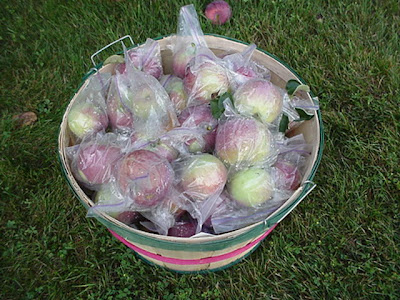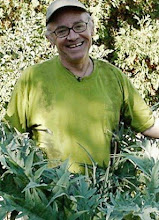 Apple bagging in full process on this tree. I have been plastic bagging apples for over a decade.
Apple bagging in full process on this tree. I have been plastic bagging apples for over a decade. I first started with these Japanese fruit bags in the 90's/ Stem at top, wire closure at center.
I first started with these Japanese fruit bags in the 90's/ Stem at top, wire closure at center. Then I went to plastic. Nick the bottom edge of the bag on the corner or both corners.
Then I went to plastic. Nick the bottom edge of the bag on the corner or both corners. Thin your fruit clusters to one apple every 6 to 8 inches.
Thin your fruit clusters to one apple every 6 to 8 inches. You can start bagging as soon as your fruit sizes to larger than a nickle to quarter size.
You can start bagging as soon as your fruit sizes to larger than a nickle to quarter size. Partially open the bag and slip it over the fruit - these bags do not have the top edge stripped off as I did with all my bags this year.
Partially open the bag and slip it over the fruit - these bags do not have the top edge stripped off as I did with all my bags this year. Zip the bag closed and staple though the zip to keep the bag closed.
Zip the bag closed and staple though the zip to keep the bag closed. The finished fruit will grow nicely in this bug free environment till maturity.
The finished fruit will grow nicely in this bug free environment till maturity. Apple bagging produced this fine harvest. Nice, hey?
Apple bagging produced this fine harvest. Nice, hey?I have been bagging my apples for over 10 years in an attempt to avoid using pesticides. In the past I did a full spray program but that was a lot of work and the need for protecting yourself from the spray begged the question - why spray? So I tried to eliminate all but the first spray to protect the early developing fruits from Plum curculio which as you saw last week can damage the young apples quickly. For the last few years I have been getting my apples bagged before the Plum curculio get at them but this year that just did not happen. I am still in the process of bagging the rest of the fruit and for the most part the damage seems to have stopped. But the next pest is on the way- the coddling moth - so I have to get the job done soon.
In the June 14, 2009 entry I have videos of the complete process but this season I will just go back over the highlights.
I started bagging apples a long time ago with Japanese paper apple bags. This was an interesting process because no one really knew how to apply these highly engineered bags. My wife, who has taught origami, suggested that we think folding in that method and so we did. The bags folded into the neatest pyramidal shapes that easily protected the apples and took windy days well. But getting the bags was a problem and they took much longer to apply than plastic. So on to the next level of extermination.
Regular zipper bags - store brand is good enough - have worked the best for me so I usually buy around 3 to 4 hundred bags and figure on a weeks worth of bagging to get the job done and then I walk away from the trees and wait for harvest.
I nick the bottom of each bag with a blade making a small slice less than a 1/4 inch on the bottom corner. You can do both sides if you want and then avoid having to cut a water filled bag later in summer as rainwater gets into the bag, fills them up as the drain just happens to be on the other side. I stuff my pocket full of bags and go to the tree. I have gotten to wearing my scissors and stapler on a rubber band around my wrist so they are easily accessible as I will need them for working each cluster of apples. The stapler is one of those small types that seems to have been made for this job.
I strip the top part of the bag off - I started doing this on every bag this year because some of my apples have real short stems and the extra bag just gets in the way. If you pull fast the top part usually comes off.
I cut away all but one apple per cluster and bag that apple. You have to get rid of fruit to allow your tree to continue to produce annually. An apple tree will naturally bear heavy on alternate years. But prune a back yard tree correctly, and the apple clusters managed will allow for a good crop every year. Prune to the largest apple in the cluster - that may not be the king fruit. Picking the largest one should ensure that there are enough seeds pollinated in the fruit to allow it to grow to maturity.
Open only one end of the bag. This allows the bag to be zipped closed easier than if the whole bag is opened. Slip the bag over the apple and zip the bag tight to the stem. Staple through the zip closure to make sure that it stays closed for the season. I have sometimes placed an apple in the middle of the bag and stapled on either side but this is extra movement and is not necessarily better bagging. I can usually bag 50 to 60 apples an hour if I am really getting it done.
Once the tree is bagged you should expect some June drop but I bag fruit clusters every 6 to 8 inches and this usually means that any drop should not really affect my crop results.
I like this process, it produces good fruit and is no more time consuming than a bi-weekly spray process and I harvest almost organic apples and recycle the plastic so it's pretty green for me.
Happy Gardening

This was a fantastic post for me!
ReplyDeleteWe've got two apple trees which we planted last spring. Last year they produced 3-5 apples each. This year the buds of one tree got attacked by some sort of leafroller and I was starting to wonder what sort of care I should apply next year.
Thank you!
Hi Michael,
ReplyDeleteFirst go to the April 25 2010 entry and look at the house finch damage to apple buds. This may be your critter. However, if you can find and identify an insect ask your county extension agent which safe insecticide you can use - maybe insecticidal soap or the bacteria that makes caterpillars sick would be possible. But it just might be birds.
Happy Gardening
Huh. Now I'm wondering. There were some web folder and/or rolled leaves on the tree, but the damage to the buds themselves looked more like your picture of the house finch damage.
ReplyDeleteThe house finch damage would make sense since we put a bird feeder about 20 feet away from the tree this year, so we've had a lot of visitors.
Maybe I'll move the feeder and keep a close eye on the tree next year.
Hi Michael,
ReplyDeleteYes, move the feeder or just stop feeding in the spring while your trees are budding and then when they have safely flowered you can go back to feeding. Or try some "flash tape" in the trees. Move it around a bit so that the birds do not get used to it but they don't like the way it moves and startles them but only till they get used to it then it stops working. Good luck next year.
Happy Gardening
So I'm wondering if I could use bags for my plums that get curculios
ReplyDelete